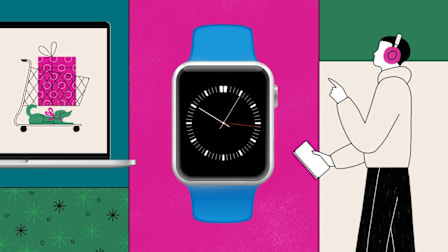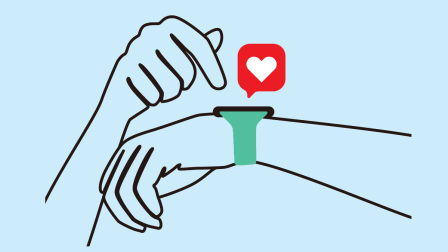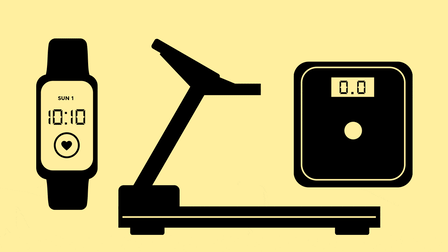How to Use Your Fitbit for Sleep Tracking
Your fitness tracker or smartwatch has a robust sleep tracking function. Here's how to use it for a better night's sleep.
When you shop through retailer links on our site, we may earn affiliate commissions. 100% of the fees we collect are used to support our nonprofit mission. Learn more.

In addition to helping you count steps and keep track of your heart rate, your FItbit is also a full-featured sleep tracker that’s easy to set up and use.
Sleep experts note that sleep trackers can help people improve their sleep by understanding their sleep patterns, although some fretful sleepers can get so wrapped up in the data that it mostly increases their stress in a counterproductive way.
To see all of CR’s sleep coverage, go to our Guide to Better Sleep.
Set Up Your Fitbit for Sleep Tracking
It’s easy to start using your Fitbit’s sleep tracking functions. Some controls are found on the device; for others you’ll need to open your smartphone app. Your Fitbit automatically tracks your sleep, but there are a variety of settings that can help you tailor the device to your needs.
Set a sleep goal. Open the Fitbit app on your phone. Tap on the round icon that may (or may not) have your photo, at the top left of the screen. Tap Activity and Wellness > Sleep > Time Asleep Goal, and use the pull-down menu to adjust your total sleep target. You can also get to this menu by hitting the gearlike Settings icon at the top left of your app’s Sleep menu.
Set bedtime and wake-up time. In the Fitbit app on your phone, tap on the round icon that may have your photo, at the top left of the screen. Tap Activity and Wellness > Sleep > Bedtime and use the pull-down menu to adjust your target bedtime. You can then do the same thing for your wake-up time.
Set a bedtime reminder. In the Fitbit app on your phone, tap on the round icon that may have your photo, at the top left of the screen. Tap Activity and Wellness > Sleep > Bedtime Reminder. When you toggle the slider for Reminder, a Time option will pop up. Tap Time to set a time for your reminder as well as picking days of the week when it will be active. (This allows you to, say, skip the reminder on the weekends.)
Set a silent alarm. To set a silent alarm, go to the main screen of your Fitbit and swipe left until you get the alarm clock icon. Tap the time to set the hours and the minutes and then toggle the slider to turn on the alarm. The alarm will vibrate but not actually ring when it’s time to wake up.
Set a smart alarm. If you find yourself tired even after getting a full night’s sleep, there’s a chance that your alarm is rousing you from a dream (aka REM sleep) or a Deep Sleep period. The Smart Wake feature monitors your sleep stages and wakes you during a Light Sleep stage, in a window of up to 30 minutes leading to the time you’ve set for the alarm. For instance, when I set a 7:07 am alarm on my Fitbit Charge 5, my potential wake-up times ranged from 6:37 a.m. to 7:07 am.
Swipe left to get to the Alarm screen on your tracker. Set an alarm if you haven’t already, and scroll down to Smart Wake. Toggle the slider and check the time range.
Adjust noise sensitivity. If you have a Sense or Versa 3 and a Fitbit Premium account, your device can monitor the noise in your bedroom, including your snoring or someone else’s. If it’s snoring, you or your partner could use the information to start a conversation with a doctor. If it’s outside noise, you could close windows and doors before bedtime or, say, get a white noise generator to drown out the hubbub. According to Fitbit, this function affects battery life, so make sure your device is charged to at least 40 percent before bed. To adjust the setting, tap the setting icon on the top right of your app’s Sleep page, then tap Sleep Sensitivity and check either Sensitive or Normal.
How Did You Sleep Last Night?
To check the previous night’s sleep metrics, you’ll first need to sync your Fitbit tracker or watch with your smartphone. Swipe up from the clock face on your tracker or watch to get to the Fitbit Today tab, where you can see your total sleep from the previous night as well as your Sleep Score (more about that in a moment). On some models you can also swipe left on the Sleep Tile to see last night’s detailed data as well as your sleep history for the week.
For more detailed information about your recent sleep, open the Fitbit app to the Today screen, and scroll down to the snoozing moon icon, which represents Sleep. The most prominent information displayed will be your total sleep duration. Which is great because that stat is really the foundation of your sleep health (and the sort of information that sleep doctors ask patients to record in a sleep diary). That screen also shows you the time you went to bed and the time you woke up.
Just below that you can see how much time you were awake. If that figure seems surprisingly high, sleep doctors note that many people have brief episodes of wakefulness throughout the night that they just don’t remember. As long as your time awake isn’t drastically cutting into your total sleep, it’s not something to worry about.
To put the previous night’s stats into perspective, tap the plus sign to see details of recent days and weeks, including both nightly sleep duration and a week-to-week average. Sleep doctors are quick to point out that no one amount of sleep is right for everyone, but if your sleep duration is consistently around 5 hours, or is fluctuating or declining, you might want to consult a healthcare practitioner.
Understanding Your Sleep Data
Just below Sleep Duration you can see sleep stages, which is a somewhat more controversial collection of stats. Sleep scientists recognize three main sleep stages: REM sleep (where most dreaming happens), deep sleep (a restorative phase for mind and body), and light sleep (which is essentially the time not spent in REM or deep sleep).
Experts say that sleep staging information, while it can be interesting, should be taken with a grain of salt. First, a wrist-worn sleep tracker like the Fitbit can’t measure your brain’s electrical activity directly in the same way a laboratory sleep study does, where a patient wears an array of electrodes. Your Fitbit, like most wearable sleep trackers, is using other metrics, like physical movement, pulse rate, and breathing, to infer which stage you’re in, so it may be less accurate.
And ultimately, this sleep staging data is less important than how much sleep you’re getting overall. Sleep experts say that unless you have serious sleep problems, your body tends to do a good job of allocating the total amount of sleep among the various stages. In my use of the Fitbit Charge 5, I noticed that the device can be quite finicky in its recording sleep stages, and factors like how the tracker is worn or just how you’re sleeping can prevent it from reporting this information on any given night.
The Fitbit app also shows a Sleep Score that’s made up of time asleep (50 percent of the score) the amount of time you spent in deep and REM sleep (25 percent of the score) and restoration (which shows how much of your sleep time is below your resting heart rate (also 25 percent).
The overall number is reported on a scale of 0 to 100, along with a one-word description like “good” or “fair.” Your Sleep Score can give you an at-a-glance sense of how you’ve been sleeping, but remember those caveats about placing too much emphasis on sleep staging, which is a major component of this stat.
If you have a Fitbit Premium account and use one of the more advanced trackers (Sense, Versa 3, Versa 2, Charge 5, Luxe, or Inspire 2), Fitbit can take this one step further and assign you a Sleep Animal—bear, dolphin, giraffe, hedgehog, parrot, or tortoise—depending on how your sleep metrics stack up against the sleep profiles they created. Bears, for example, tend to have a consistent sleep schedule and fall asleep quite quickly. To get a Sleep Animal profile you need to wear your device to bed for 14 nights in a given month.
One thing to consider: Fitbit is owned by Google, so it’s likely that the company is collecting your sleep data and other fitness information and may be using it for product development or for targeting ads.
Finally, remember that a sleep tracker on its own won’t actually improve your sleep, says Michael Grandner, director of the Sleep Research Program at the University of Arizona, who has consulted with Fitbit. A sleep tracker is more like a bathroom scale than a weight-loss plan—and just like a scale, it can be helpful or harmful. On the downside, if the morning read of your Fitbit’s sleep stats leads you to start “doomscrolling” about the health issues that can be caused by a lack of sleep, your watch probably isn’t doing you any favors. “No one has ever slept longer or better by trying harder,” Grandner says.
On the other hand, he says, if seeing how much (or how little) you’re sleeping encourages you to practice good sleep hygiene by going to bed at a regular time and sleeping in a cool, quiet, darkened room, then it can help you get the rest you need.




















